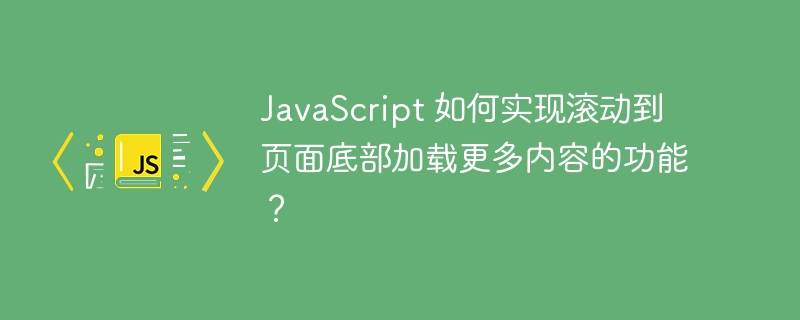

JavaScript How to implement the function of scrolling to the bottom of the page to load more content?
In web development, the function of scrolling to the bottom of the page to load more content is a very common requirement. Typically, as you scroll down to the bottom of the page, more data is automatically loaded to provide a better user experience and a seamless reading experience. This article will introduce how to use JavaScript to implement this function and give specific code examples.
To implement the function of scrolling to the bottom of the page to load more content, you mainly need to master two aspects of knowledge: detecting scroll events and determining whether the page has scrolled to the bottom. The implementation methods of these two aspects will be introduced in detail below.
By listening to scroll events, you can monitor the scrolling of the page in real time and trigger corresponding operations when more content needs to be loaded. In JavaScript, you can use the onscroll event to detect scrolling events. The sample code is as follows:
window.onscroll = function() {
// 滚动事件触发时的处理逻辑
};When the scrolling event is triggered, the processing logic in this code will be executed. Next, we need to determine whether the page has scrolled to the bottom.
To implement the function of scrolling to the bottom of the page to load more, it is necessary to determine in real time whether the current scroll position of the page has reached the bottom. In JavaScript, you can determine whether the page has reached the bottom through the three properties scrollTop, scrollHeight, and clientHeight. The specific judgment conditions are as follows:
if (document.documentElement.scrollTop + window.innerHeight >= document.documentElement.scrollHeight) {
// 页面已经滚动到底部的处理逻辑
} In the above code, document.documentElement.scrollTop represents the scroll height of the page, window.innerHeight represents the height of the browser window, document.documentElement.scrollHeightRepresents the height of the entire page. When the page scrolls to the bottom, the value of scrollTop innerHeight will be greater than or equal to the value of scrollHeight.
When the page scrolls to the bottom, the action of loading more content needs to be triggered. This operation can be an asynchronous request to the server to get more data and then insert the data into the page. Specific code examples for loading more content are as follows:
function loadMoreContent() {
// 异步请求服务器获取更多数据
// 插入数据到页面中
}
window.onscroll = function() {
if (document.documentElement.scrollTop + window.innerHeight >= document.documentElement.scrollHeight) {
loadMoreContent();
}
};In the loadMoreContent() function, you can use an asynchronous request to request more data from the server. After the request is successful, the data is inserted into the page to enable the function of loading more content.
The above is the method and code example of using JavaScript to implement the function of scrolling to the bottom of the page to load more content. By listening to scroll events and determining whether the page has scrolled to the bottom, when the page scrolls to the bottom, it can trigger the operation of loading more content, thereby achieving a better user experience and a seamless reading experience.
The above is the detailed content of How to implement the function of scrolling to the bottom of the page to load more content in JavaScript?. For more information, please follow other related articles on the PHP Chinese website!
 How to solve the problem that css cannot be loaded
How to solve the problem that css cannot be loaded
 What to do if an error occurs in the script of the current page
What to do if an error occurs in the script of the current page
 What to do if css cannot be loaded
What to do if css cannot be loaded
 What to do if loading dll fails
What to do if loading dll fails
 Main uses of Linux operating system
Main uses of Linux operating system
 How to turn off sublime auto-completion
How to turn off sublime auto-completion
 How to open php in a web page
How to open php in a web page
 How to solve the problem that js code cannot run after formatting
How to solve the problem that js code cannot run after formatting
 How to open csv file
How to open csv file




